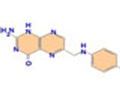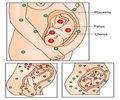Pregnant women who take some types of vitamin supplements or eat fortified foods may be passing excess vitamin A to their developing fetuses.
A new University of Wisconsin-Madison study suggests that pregnant women who take some types of vitamin supplements or eat fortified foods may be passing excess vitamin A to their developing fetuses. Reported in the October issue of the Journal of Comparative Medicine, the finding could guide efforts to develop future formulations of vitamins.
Best known as retinol because it produces the eye's retinal pigments, vitamin A is important for fetal development and to establish and maintain healthy lactation in breast-feeding mothers. For these reasons, many U.S. women are either prescribed// or begin taking over-the-counter vitamin supplements during the first trimester of pregnancy.However, it's still unclear how much vitamin A is too much, making it important to learn the levels at which vitamin A compounds - present as retinyl acetate and palmitate in supplements - begin affecting the early fetus, says UW-Madison nutrition professor Sherry Tanumihardjo.
"The high intake of vitamin A from supplements and fortified foods worldwide has caused us to be concerned," she says. With colleagues Ei Terasawa, professor of pediatrics in the School of Medicine and Public Health and the Wisconsin National Primate Research Center, and first author Jordan Mills, a nutritional sciences graduate student, Tanumihardjo has found that when mother monkeys consume excess vitamin A in fortified food, this results in increased storage of the vitamin - in a form called retinyl ester - in fetal livers during early gestational stages.
Liver storage may occur when vitamin A levels outstrip the immediate demands of the developing fetus, possibly as a way to protect against vitamin A toxicity. Tanumihardjo attributes the excess vitamin A to lab diets containing high concentrations of the vitamin. "Those diets should be reformulated," Tanumihardjo says. In addition, new vitamin A formulations for people might be developed that could still meet the needs of mother and fetus, while avoiding the problems that excess vitamin A might cause, she adds.
Previous data from human fetuses suggest that liver vitamin A concentrations increase until sometime in the third trimester. They then drop steadily until birth, after which the baby's consumption of breast milk causes them to rise again. But until now, early human data - or any primate data, for that matter - has been rare, says Tanumihardjo.
"Although data exist for late-stage fetal and neonatal liver vitamin A storage in humans and rodents, few data exist regarding early-stage fetal tissues of all species, including primates," she says. In addition to sharing approximately 95 percent genetic homology, Old World monkeys and humans exhibit comparable organ growth rates and sizes throughout fetal and postnatal development, making monkeys useful models for early human development.
Advertisement
The excess vitamin A the researchers discovered in the monkeys didn't appear to cause problems, likely because the maternally derived vitamin A was stored primarily as relatively harmless retinyl esters in the liver, rather than being converted to harmful retinoids. This type of storage occurs either through fetal conversion of retinol to retinyl esters or direct transmission of retinyl esters from mother to fetus, or as a combination of these routes, Tanumihardjo says. Preferential shunting of maternally derived vitamin A to storage as retinyl esters may help protect against vitamin A toxicity in the fetus.
Advertisement
But have humans similarly adapted to protect their early fetuses from excess vitamin A concentrations? The new research indicates that this may be so; however, Tanumihardjo is eager to compare her monkey data to more human data, especially earlier in development.
The research was supported by the National Institutes of Health and the Wisconsin National Primate Research Center.
Source: UB-News Service
Source-IANS
LIN/M











